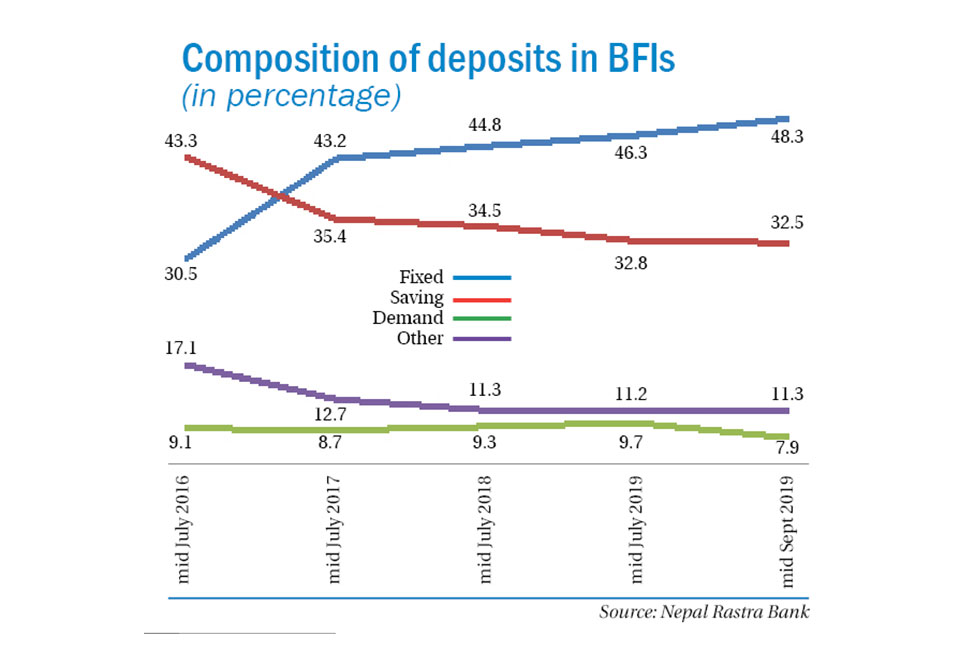
OR
High interest rates alter composition of bank deposits
Published On: October 31, 2019 10:38 AM NPT By: Republica | @RepublicaNepal

Reversing a long trend, share of fixed-term deposits outpaces saving deposits
KATHMANDU, Oct 31: The shortage of lendable fund in bank and financial institutions (BFIs) and their competition to get hold of longer-term money has altered the composition of deposits in the banking system.
While the share of saving deposits used to be higher in the BFIs until 2016, now fixed deposits account for highest share in the banking sector.
According to the data of Nepal Rastra Bank (NRB), the share of fixed-term deposit in BFIs rose to 48.5 percent of the total deposit in the second month (mid-September) of the current Fiscal Year 2019/20 compared to 30.5 percent in mid-July 2016.
On the other hand, the share of saving deposits in total deposits has fallen to 32.5 percent in mid-September this year from 30.5 percent in mid-July 2016.
According to the data, the share of demand deposit stands at 7.9 percent and 11.3 percent of ‘Other’ type of deposits as of mid-September this year.
Bankers attribute this reverse in the composition to a sharp rise in the interest rates of the fixed-term deposits in recent years.
“Until five years ago, the saving deposits used to account for nearly 45 percent of deposits while the share of saving deposits used to be around 30 percent. Now, it’s just the opposite,” said Manoj Gyawali, general secretary of Development Bankers Association Nepal (DBAN) -- the umbrella organization of chief executives of ‘B’ class development banks of the country.
The high interest rates in fixed deposits owing to the shortage of lendable funds in the BFIs not only lured new depositors who were looking for less risky investment avenues but also prompted the existing depositors from shifting their deposits from saving to the fixed-term accounts.
Depositors have become interest rates-sensitive in recent years due to widening of the difference of rates between saving and fixed-terms deposits, according to bankers.
“Earlier, savers were not concerned where there money was as there was not much difference in the interest rates between saving and fixed-term. However, BFIs started to raise the interest rates and the gap with the saving rates widened. This tempted depositors to shift their deposits from saving to fixed-term deposits due to higher return,” added Gyawali, who is also the CEO of Jyoti Bikas Bank Ltd.
The interest rates on fixed-term deposit climbed up to 13 percent while the saving rates went up to 8 percent. However, the Nepal Bankers’ Association (NBA) -- the umbrella organization of chief executives of 28 commercial banks -- decided to impose a cap on the deposit rates to prevent it from going upward spiral.
Currently, the rate of fixed-term deposit for commercial banks has been capped at 9.25 percent while they cannot offer more than 6.5 percent on saving deposits.
While the increase in the return in the fixed-term deposit rates rewards depositors, it’s a bane for BFIs and borrowers.
“Depositors may celebrate the higher return in fixed deposits. However, the cost of funds for BFIs will increase as it means higher interest expenses for a longer term. When the cost of funds increases, they will raise their interest rates on loans which will adversely impact borrowers,” added Gyawali.
You May Like This

BFIs’ deposits collection increases by a notable amount
KATHMANDU, March 29: The banks and financial institutions (BFIs) have been under a cushion of liquidity position with an increase in... Read More...

NRB asks BFIs not to alter interest rates of loan without discussing with borrowers
KATHMANDU, Dec 16: Banks and financial institutions (BFIs) have been barred from altering their interest rates on fixed-rate loans without receiving... Read More...

BFIs not to increase lending until govt ups spending
KATHMANDU, April 27: Grappled with shortage of lendable funds, bank and financial institutions (BFIs) have tweaked their credit expansion strategy. ... Read More...





Just In
- NRB introduces cautiously flexible measures to address ongoing slowdown in various economic sectors
- Forced Covid-19 cremations: is it too late for redemption?
- NRB to provide collateral-free loans to foreign employment seekers
- NEB to publish Grade 12 results next week
- Body handover begins; Relatives remain dissatisfied with insurance, compensation amount
- NC defers its plan to join Koshi govt
- NRB to review microfinance loan interest rate
- 134 dead in floods and landslides since onset of monsoon this year












Leave A Comment